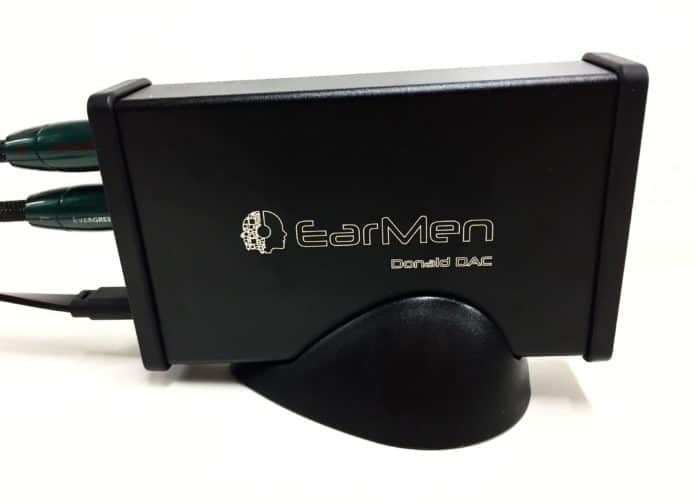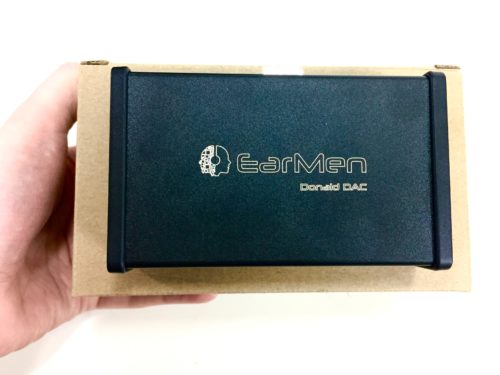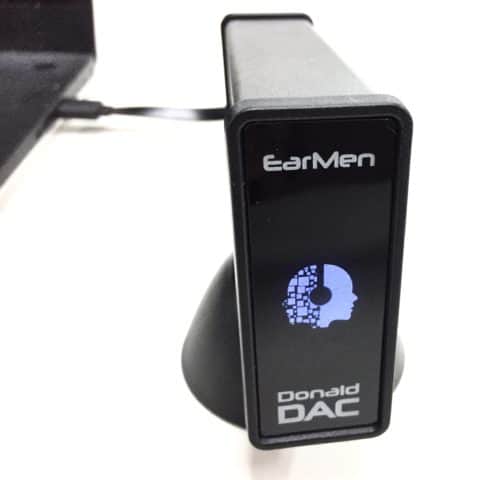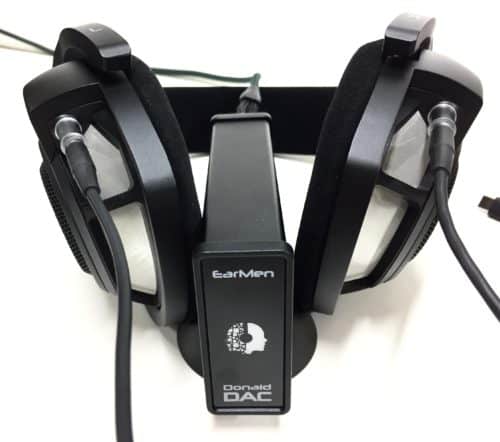In the midst of my endless quest to listen to all the budget earphones, I’ve been handed some relief in the form of the EarMen Donald DAC. Finally, I get to review a DAC! That’s not to say this is an easy review to do – when you’re not equipped with state-of-the-art measuring technology, it’s actually fairly difficult to review a DAC. But it does give me an excuse to haul out the most detailed pair of headphones I can get my hands on (the HD800S) and do some extended listening sessions.
If you’re not familiar, DAC stands for Digital-(to)-Analog Converter. It’s the device that takes in a digital signal from your music files and spits out the audio signal that your headphone’s transducer will vibrate in sync with in order to produce music.
At $99, the Donald DAC finds itself in the midst of a bloodthirsty competition. While high-end audiophile DACs can go for thousands of dollars, we’re at the point in history where you can already get quite a good one for under $100. In other words, the Donald DAC faces stiff competition.
In the Box
I’m 95% sure my unit didn’t come with a USB cable, especially because I started using it immediately after opening the box. Perhaps that’s because I received a review unit. Or perhaps the cable fell victim to my chronic tendency to misplace things. Please let me know if you find a USB-A to USB-C cable with no explanation as to how it got there – it may very well be mine.
- Donald DAC
- Donald DAC proprietary stand
- nothing else (?)
Build, Appearance, Functionality
The EarMen claim that the Donald DAC is a portable DAC, and portable it is. Its diminutive size and sturdy build means that it’ll be easy to throw it into a backpack or a suitcase for some travel. Unfortunately, it won’t fit in your pocket, and it doesn’t come with an amp built in. This serves better as a single component of a portable system.
As I noted earlier, the build feels sturdy and secure. Most of the body is made of metal, although both the front and back are made of plastic. It’s a nice plastic, though. The front has a little EarMen logo that lights on when the Donald DAC is plugged in. The unit has a reassuring weight to it.
I was less enamored with the included stand. It’s made of plastic, but it feels sturdy, so that’s no problem. What is a problem is that the stand has no rubber on the bottom, meaning it had a tendency to slip and slide around on my desk. I’d love to see even a thin layer of rubber added to the bottom of the stand to prevent this issue.
Sound
To test the Donald DAC, I ran it through the iFi Micro iDSD Black Label into the HD800S, then switched back and forth between the iDSD’s built-in DAC and the Donald DAC. Unfair? Well, perhaps, but I already know a few $100 standalone DACs that boast performance comparable to the iDSD, so it does give me a good idea of where the Donald DAC stands, performance-wise.
Let me also preface this section by saying that I’m not the kind of audiophile who absolutely demands a reference-grade rig. I buy products because I consider them interesting, not because they sound technically perfect. As a result, I usually find that the bottleneck in my system is the headphone, rather than the DAC. It also means that reviewing a DAC like this is kind of an alien concept to me. The Donald DAC supports DSD256 and PCM 32Bit/384kHz playback, but I was exclusively feeding it 16-bit/44.1kHz FLAC files, because that’s what I have at my disposal. But upon listening to the Donald DAC, I found that I could hear some nuanced differences between it and other DACs.
Results
The results: the EarMen Donald DAC sounds pretty good. I got no audible hiss and no audible power supply hum, which already puts it above my computer’s onboard audio. However, I noticed that it introduced a tiny bit of audible harmonic distortion, which made the presentation slightly less detailed and overall a bit squished-sounding. A bit warmer-than-neutral, yes. Fully transparent, not really.
Let me give you an example of how this can manifest: in My Bloody Valentine’s “If I Am,” there’s a single note played by the guitar at 1:29 that stands out from the mix, partly because it’s louder and partly because it’s much less timbrally complex than what’s going on around it. This makes it a good candidate for detecting harmonic distortion: a detectable amount of distortion here will bring the note even further forward in the mix (because the harmonic content in the upper mids will increase just a hair). I noticed that the Donald DAC tends to render this note with greater intensity and less clarity than the iFi iDSD’s DAC.
This might mean that the Donald DAC might introduce just a tiny bit of midrange fatigue potential into your system, in comparison with extremely low-distortion competing DACs like the the Schiit Audio Modi 3.
However, this might make it a good candidate for consideration for those who want to add a very tiny element of “directness” or “forwardness” to your system – though I’d recommend starting with your headphones if that’s the case. It also means that you lose a little bit of low-level detail. Of course, you have to remember that I was using the HD800S, one of the most resolving headphones ever made, for this review – if you’re using something slightly less resolving, you may not notice.
Overall, the Donald DAC is not neutral or transparent, but I expect it may still find its fans in people who like a warm, lively sound.
Spare Remarks
- Yes, the name is an homage to Donald Duck, if you haven’t noticed. Ha, ha.
- EarMen is a Chicago-based company, but the Donald DAC is manufactured “in Europe.” Where in Europe, EarMen? Where in Europe?
Pros and Cons
Pros: Nice-looking design, nice materials, portable, funny name, “forward” sound
Cons: More resolving / transparent DACs available for the price
In Conclusion
The EarMen Donald DAC is a nice little piece that’ll sit prettily on your desk, and the sound is fine. If you’re attracted to the looks, go for it – it’ll almost certainly provide significantly better-quality sound than your computer’s onboard DAC. Alternatively, if you want a warmer, livelier, more intimate sound at the expense of detail, you might be interested. But otherwise, I’d look at more tried-and-true options (Schiit Modi 3, Khadas Toneboard, or the Grace SDAC come to mind) for your entry-level DAC, at least until measurements of this one arrive. We shall see – I’d love to be proven wrong here.
Find more out about the Donald DAC on EarMen’s website.
As a disclaimer, MajorHifi may receive commissions from retail offers.
MAJORHIFI may receive commissions from retail offers.












